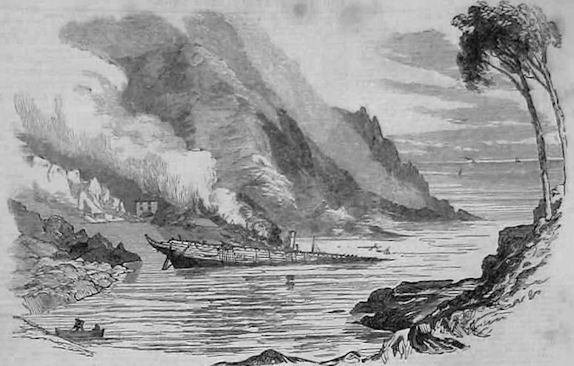Croesus
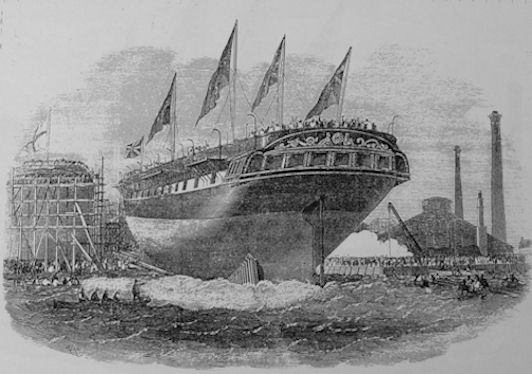
The shafting altogether extends about 105 feet, and ranges through what is called the funnel, a very spacious one, upwards of 70 feet long, 6 feet high, and 4 feet in width. On each side is a fresh water tank, which contains nearly 60 tons. Leading to these trunks, and ranged along the tunnel, are the pipes from the water condensers, fitted to distil 1200 gallons of fresh water per diam.
No. 4 on 2nd January 1855 at London.
Certificate granted 15th December 1853, No. 654.
Launched by Miss Rolt.
Name originally intended for this ship was the 'Jason'.
Crew in 1853 - 80. Crew in 1855 - 120.
On the voyage to Australia she had 966 tons of coal for the outward passage and 400 tons for the homeward voyage, which may be used outwards if the coals run short.
4th June 1853. Date intended to launch the ‘Jason’
16th December 1853. Expected to arrive at Southampton, Captain J. V. Hall, from the Thames.
22nd December 1853. Arrived at Southampton from the Thames.
16th December 1853. Expected to arrive at Southampton, Captain J. V. Hall, from the Thames.
22nd December 1853. Arrived at Southampton from the Thames.
10th January 1854. Due to sail from Southampton for Melbourne.
16th January 1854. Arrived at Lisbon at noon. Had a fracture in the feed pipes.
24th January 1854. Sailed from Lisbon after picking up the mails, for the Australian ports, which were despatched from Liverpool on the 4th December on the sailing ship 'Matitda Wattenbach' which was dismasted and had to put into Tagus. While she was there she had to rectify machinery defects, plus obtaining additional complement of hands. An accident while getting underweigh in which the Boatswain received a severe blow from a capstan bar, causing his death; and another man had his arm broken at the same time.
27th January 1854. Passed Teneriffe.
30th January 1854. Passed the Cape de Verds.
28th February 1854. Arrived at Cape Town, and detained due to a defect in the gear for lowering her screw had caused the latter to damage her keel, and to stop a leak in the screw shaft tube.
10th March 1854. Sailed from Cape Town.
10th April 1854. Arrived at Port Phillip after a series of machinery breakdowns. Among other difficulties, the shears, which had to be rigged up for hoisting the screw, did not answer the purpose well, and the chains employed so far interfered with the action of the compass, that another one had to be planted forward to steer the ship by.
16th April 1854. Sailed from Port Phillip.
19th April 1854. Arrived at Sydney.
1st / 8th May 1854. Arrived at Moore’s Wharf, Sydney.
10th May 1854. Undergoing repairs at Sydney as she is very leaky about the plates of her stern.
22nd May 1854. Able seaman Peterson was found floating in the harbour after an accident will sailing in the harbour.
29th May 1854. At Berry’s Bay, Sydney. A report from the local paper states ‘The repairs of this steamer are progressing satisfactorily; the erection of the coffer-dam is now completed, and is sufficiently water-tight to be kept free with one pump – the leak which apparently is confined to the sternpost, can be got at with ease; and it is hoped all the necessary renovations will be completed in a few days; the diver went down to examine her bottom reported that all outside the dent is perfectly sound.’
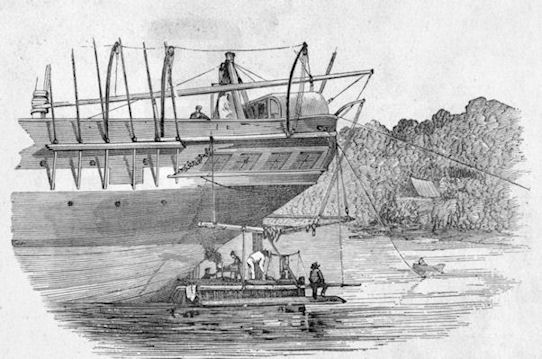
15th August 1854. Afloat again. The caissons fitted in order to repair her damages were removed by Mr. Dawson, the contractors.
25th August 1854. After 4 mouths in the harbour in Port Jackson the repairs to a leak had been completed.
26th August 1854. Went on a sea trail in a very strong gale.
2nd September 1854. Sailed from Sydney via Melbourne, for England with 37 passengers, and gold dust to the value of £304,344. Captain Hall.
5th September 1854. Arrived at Melbourne at 6 p.m.
9th September 1854. Due to arrive at Southampton from Australia, but was receiving the mail from Adelaide from the ‘Bosphorus’.
10th September 1854. Sailed from Port Phillip.
12th September 1854. During the passage across the Pacific she lost one blade of her screw.
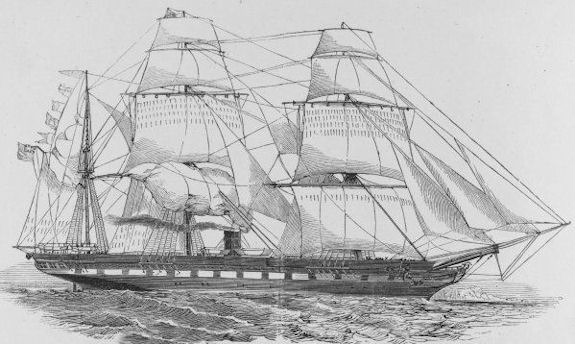
29th October 1854. Replaced screw with the spare.
8th October 1854. Was advertised to depart for a second voyage to Sydney, but had to be cancelled.
29th November 1854. Sailed from St.Vincent.
14th December 1854. Arrived at Southampton with £284,344 in gold dust.
December 1854. Became a transport for the English Government.
18th December 1854. First ship to enter the New Graving Dock at Southampton for a thorough overhaul. She is being fitted for the conveyance of troops.
5th January 1855. Due to be ready as a troopship. Has been ordered to steam to Portsmouth to embark 1200 troops for the Crimea.
13th January 1855. Still in the large graving dock at Southampton undergoing repairs necessary to her stern and keel.
25th January 1855. Left the Southampton Graving Dock, chartered by the English Government for the Crimea.
1st February 1855. Adjusted her compasses ready for service.
8th February 1855. Embarked troops at Portsmouth for Malta. Transport No. 191. Captain J. V. Hall.
9th February 1855. Arrived at Plymouth in the morning at 7 o’clock. In the forenoon they were closely inspected. All the men were in good spirits, and were provided with sufficient accommodation below to prevent the necessity of any remaining on deck. Later in the afternoon more troops and stores were embarked. They were marched from the Citadel to the Royal William Victualling Yard and boarded the steam tug ‘Confiance’ which conveyed them to the Sound to board the ship. She sailed at 5·30 p.m.
15th March 1855. Received about 600 tons of stores, 120 men of the 20th Regiment, and a like number of the 95th for Malta.
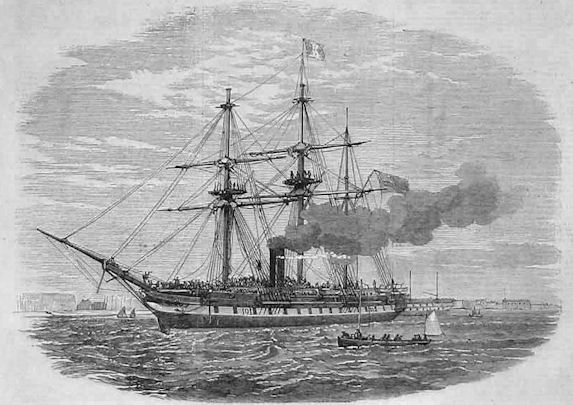
17th March 1855. An accident happened on the way to Spithead by the swamping of a boat which was towing astern, and by which one of her crew lost his life, by being washed out and sinking before any assistance could be given.
23rd March 1855. Passed Gibraltar.
3rd April 1855. Arrived at Malta. Disembarked 255 men of the 20th and 95th Regiments. Corporal Strickland and a child died on the passage, and also Capt. Beller’s charger.
24th April 1855. Sailed from Genoa at 09.00hrs with the sailing transport ‘Pedestrian’ in tow.
24th April 1855. Destroyed by fire off Portofino, in the Gulf of Genoa, when conveying troops from Sardinia to the Crimea. Only five or six lives were lost. A widow put off alone in her boat to their assistance, when so many jumped in that the boat was upset, and she was unfortunately drowned. Beached. Total loss. Under-insured. She was insured for only £57,000, and had cost £99,000.
